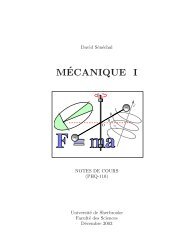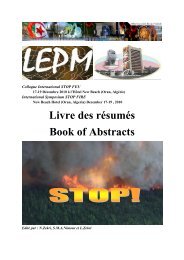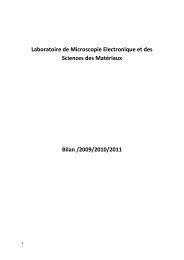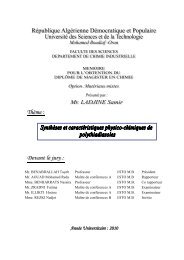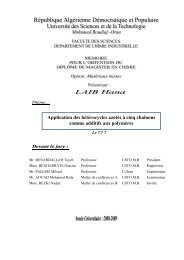Baziz Meriem magister.pdf - Université des Sciences et de la ...
Baziz Meriem magister.pdf - Université des Sciences et de la ...
Baziz Meriem magister.pdf - Université des Sciences et de la ...
Create successful ePaper yourself
Turn your PDF publications into a flip-book with our unique Google optimized e-Paper software.
II.5. Polyaniline<br />
II.5.1. Historique<br />
La polyaniline est sans doute le plus ancien polymère conjugué, en eff<strong>et</strong> son existence<br />
remonte à 176 ans ; <strong>de</strong>puis 1834, ou elle a été acci<strong>de</strong>ntellement obtenue par Runge sous forme<br />
d’un dépôt noir indésirable [21]. En 1862, H.L<strong>et</strong>heby réussit à synthétiser pour <strong>la</strong> première<br />
fois <strong>la</strong> polyaniline par oxydation électrochimique <strong>de</strong> l’aniline [22] sous <strong>la</strong> forme d’un<br />
précipité vert foncé, dans <strong><strong>de</strong>s</strong> conditions aqueuses aci<strong><strong>de</strong>s</strong>, baptisé sous le non <strong>de</strong> noir d’aniline<br />
(Figure II.8).<br />
Figure II.8 : Formule <strong>de</strong> <strong>la</strong> polyaniline préparée par L<strong>et</strong>heby [22].<br />
Pendant les années qui ont suivi, <strong>de</strong> nombreux chercheurs comme Lightfoot en 1863,<br />
Coquillon en 1875 <strong>et</strong> Ni<strong>et</strong>ski en 1878 ont commencé à s’intéresser à ces nouveaux produits.<br />
Au début du 20 eme siècle, les chimistes ont entrepris l’étu<strong>de</strong> <strong>de</strong> ce noir d’aniline. Ainsi, en<br />
1907 Willstatter <strong>et</strong> al. [23], ont considéré le noir d’aniline comme un composé formé d’une<br />
chaine à huit noyaux ayant une structure indamine (Figure I1.9).<br />
Figure I1.9: Structure <strong>de</strong> l’indamine<br />
La constitution <strong>de</strong> ce polymère est restée longtemps mal définie, ce n’est qu’en 1910<br />
que Green <strong>et</strong> Woodhead. [24] s’impose comme les pionniers dans <strong>la</strong> recherche concernant <strong>la</strong><br />
polyaniline. Ils proposent une <strong><strong>de</strong>s</strong>cription <strong>de</strong> sa structure chimique. Le groupe <strong>de</strong> Surville<br />
montra en 1968 les propriétés redox <strong>de</strong> <strong>la</strong> polyaniline [25]. En outre, pendant toute c<strong>et</strong>te<br />
pério<strong>de</strong>, rien n'a été connu au suj<strong>et</strong> <strong>de</strong> ses propriétés électriques. Néanmoins, l’intérêt vis avis<br />
<strong>de</strong> ce polymère ne s’est vraiment développé qu’après <strong>la</strong> découverte par Shirakawa <strong>et</strong> al. <strong><strong>de</strong>s</strong><br />
propriétés <strong>de</strong> conduction du polyacétylène [6].



